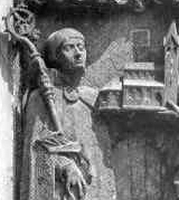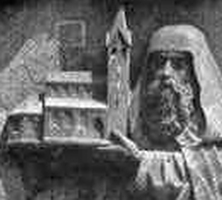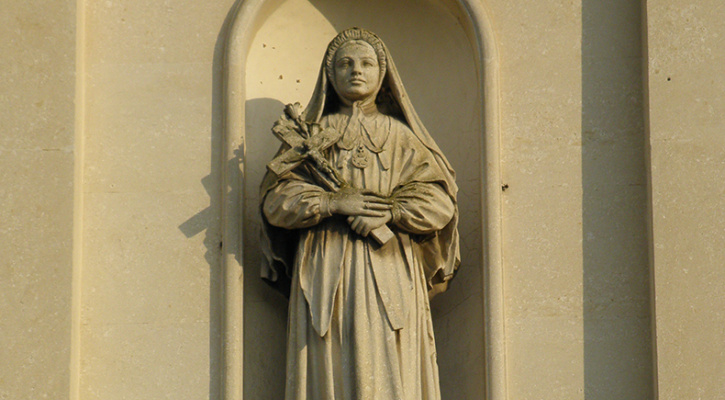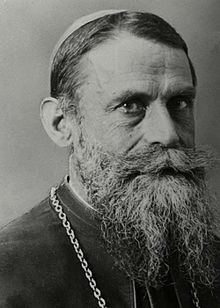St. Alexander
Feastday: February 26
Death: 434
Martyr of Arumentum and a companion of Verulus, Secundius, and others.
Saint Victor the Hermit
Also known as
• Victor of Arcis
• Vittre, Vitre
Profile
Born to the nobility and raised in a pious, well-educated family. Priest. Hermit at Arcis-sur-Aube in the Champagne region of France. His life and wisdom caused many conversions. Saint Bernard of Clairvaux composed an Office and several hymns about him.
Born
6th century at Troyes, France
Died
• 6th-century at Saturniac (modern Saint-Vittre), diocese of Troyes, France of natural causes
• buried at the Benedictine monastery at Montiramey
Saint Paula of Saint Joseph of Calasanz
புனித_பவுலா (1799-1889)
பிப்ரவரி 26
இவர் (#StPaulaOfStJosephOfCalasanz) ஸ்பெயின் நாட்டிலுள்ள பார்சிலோனாவில் பிறந்தவர். இவரது தந்தை ராமோன், தாய் விசன்டா ஃபோர்னஸ் மோண்டல் என்பவராவர்.
இவரது பெற்றோர் இறைவன்மீது ஆழமான நம்பிக்கை கொண்டிருந்ததால், இவரும் சிறுவயது முதலே இறைவன்மீது ஆழமான நம்பிக்கைகொண்டு வாழ்ந்து வந்தார்.
இவருக்குப் பத்து வயது நடக்கும்போது இவரது தந்தை இறந்தார். அதனால் இவர் துணிகளை நெய்து, தன்னுடைய குடும்பத்திற்கும் தனது பங்கிலிருந்த ஏழைக் குழந்தைகளுக்கும் உதவி வந்தார்.
இவருக்கு முப்பத்து வயது நடக்கும்போது இவர் தன் தோழியான ஐனஸ் பஸ்குட்ஸ் (Ines Busquets) என்பவரோடு இணைந்து, ஜெனோரா என்ற இடத்தில் பள்ளிக்கூடம் ஒன்றை நிறுவினார். அது வெற்றிகரமாகச் செயல்பட 1842 ஆம் ஆண்டு இவர் கல்லூரி ஒன்றையும், 1846 ஆம் ஆண்டு மீண்டுமாக ஒரு பள்ளிக்கூடத்தையும் நிறுவினார்.
இவற்றையெல்லாம் நிர்வகிக்க இவர் 1847ஆம் ஆண்டு மரியாவின் மகள்கள் (Daughters Of Mary) என்றொரு சபையை நிறுவினார். இது திருத்தந்தை ஒன்பதாம் பயஸ் என்பவரால் 1960 ஆம் ஆண்டு அங்கீகரிக்கப்பட்டது.
தான் நிறுவிய சபையின் தலைவியாக ஒருசில ஆண்டுகள் இருந்த இவர், தன் வாழ்வின் இறுதிவரைக்கும் இறையன்புக்கும் பிறரன்புக்கும் மிகச்சிறந்த எடுத்துக்காட்டாக விளங்கினார்.
இவர் 1889ஆம் ஆண்டு இறையடி சேர்ந்தார். இவருக்கு 2001 ஆம் ஆண்டு திருத்தந்தை புனித இரண்டாம் ஜான்பால் அவர்களால் புனிதர் பட்டம் கொடுக்கப்பட்டது.
Also known as
• Paula Montal Fornes
• Paola...
Profile
Daughter of Ramon and Vicenta Fornes Montal. Raised in a large and pious family in a small seaside village. Her father died when Paula was 10 years old. She worked as a seamstress and lace-maker, and helped raise her siblings, then helped in her parish to care for other children.
At age thirty, still single and devoting herself privately to God, she and her friend Inez Busquets opened a school in Gerona to provide a good education mixed with spiritual guidance. The school was such a success that she was able to found a college in May 1842, and another school in 1846. To staff and manage the schools, she founded the Daughters of Mary (Pious School Sisters; Escolapias) on 2 February 1847, and took the name Paula of Saint Joseph of Calasanz. Paula served as the leader of the congregation, and they received approval from Pope Blessed Pius IX in 1860. These schools have now spread to four continents.
Born
11 October 1799 at Arenys de Mar, near Barcelona, Spain
Died
26 February 1889 at Olesa de Montserrat, Barcelona, Spain of natural causes
Canonized
25 November 2001 by Pope John Paul II
Blessed Robert Drury
Also known as
Robert Drewrie
Additional Memorials
• 22 November as one of the Martyrs of England, Scotland, and Wales
• 29 October as one of the Martyrs of Douai
Profile
Studied at the English College, Rheims, France in 1588, and the English College, Valladolid, Spain in 1590. Ordained at Valladolid in 1593. Returned to England in 1593 to minister to covert Catholics around London, England. One of the signers of the loyal address of 31 January 1603 which acknowledged the queen as lawful sovereign on earth, but maintained their loyalty in religious matters to the Pope. When James I came to the throne, the king required them to sign a new oath which acknowledged his authority over spiritual matters. Robert refused, and was arrested in 1606 for the crime of being a priest. He was offered his freedom if he would sign the oath; he declined. Martyr.
Born
c.1567 at Buckinghamshire, England
Died
hanged, drawn, and quartered on 26 February 1607 at Tyburn, London England
Beatified
22 November 1987 by Pope John Paul II
Blessed Martino Martini
Profile
Convert to Christianity. He joined the Franciscans, though he never made his solemn profession or became a friar. He did the most menial work around the convent of San Francesco in Lisbon, Portugal, going barefoot, living off little but bread and water, and spending all free time in prayer.
Legend says that when he was working as a cook for the house, he got so taken up in prayer that he neglected to cook breakfast for the house. Came later in the day when he needed to get cooking, he was again lost in his prayers; one of the friars came to check on him and found angels doing the cooking for him.
Born
late 12th century
Died
1249 in Lisbon, Portugal of natural causes
Saint Alexander of Alexandria
Also known as
Alessandro di Alessandria
Profile
Known as a pious youth. Bishop of Alexandria, Egypt in 313. Worked against Arianism, and excommunicated Arius when he preached in the area around Alexandria. Key figure in the Council of Nicaea in 325. Patriarch of Alexandria. Doctor of the Church.
Born
3rd century in northern Egypt
Died
February 326 at Alexandria, Egypt
Blessed Piedad de la Cruz Ortiz Real
Also known as
Tomasa Ortiz Real
Profile
Founded the Congregation of Salesian Sisters of the Sacred Heart of Jesus.
Born
12 November 1842 in Bocairente, Valencia, Spain as Tomasa Ortiz Real
Died
26 February 1916 in Alcantrarilla, Murcia, Spain of natural causes
Beatified
21 March 2004 by Pope John Paul II
Saint Porphyrius of Gaza
தூய பொர்பீரியுஸ் 4ம் நூற்றாண்டின் மத்தியில் ஒரு வசதிமிக்க கிரேக்க குடும்பத்தில் பிறந்தார். 25ம் வயதில் எகிப்திலுள்ள ஒரு துறவு மடத்தில் சேர்த்தார்.சில ஆண்டுகட்டுப் பிறகு புனித இடங்கட்கு திருப்பயணம் மேற்கொண்டார். அதில் அவர் கண்ட இயேசுவின் பாடுகள் அவரை ஒரு சன்னியாச வாழ்வை மேற்கொள்ள தூண்டியது. யோர்தான் ஆற்றின் அருகில் அமையப்பெற்ற ஒரு குகையில் வாழ்ந்ததால் அடிக்கடி இவரால் புனித இடங்களை சந்திக்க முடியவில்லை. அவருடைய செயல்களும் விசுவாசமும் சிறப்பாக பாராட்டப்பட்டு கி.பி. 392ம் ஆண்டில் திருச்சிலுவையின் அருளிக்கங்களை பாதுகாக்கும் பொறுப்பு இவரிடம் ஒப்படைக்கப்பட்டது. 3 ஆண்டுகட்குப் பிறகு அவர் விரும்பபவிடினும் கூட பாலஸ்தினத்திலுள்ள காசா பகுதியின் ஆயராக அருட்பொழிவு செய்யப்பட்டார்.
ஒரு சிறப்பான ஆயர்
ஆயருடைய உயரிய நிலை அவருடை வாழ்வு முறையை மாற்றிவிட வி;ல்லை. எளிய உடைகளை அணிந்தும் எளிமையான வாழ்வு வாழ்ந்தும் சாதாரண மக்களின் வேலையைச் செய்தும் வாழ்ந்து வந்தார். கிறிஸ்தவ விசுவாசத்தைப் பரப்புவதே மிக முதன்மையான பணியாகச் செய்தார்.அச்சமயத்தில் பாலதீனத்தில் கிறிஸ்தவர்கட்கும் பிற மறையைச் சார்ந்தவர்கட்கும் இடையே இருந்த முரண்பாடுகளால் இவருடைய பணி மிகவும் கடினமானதாக இருந்தது. அருடைய அயரா முயற்சியின் விளைவாக அவருடைய பணிக்காலத்தின் முடிவில் அந்நிய மதங்கள் தன்னுடைய மறைமாவட்டத்தில் இல்லை எனுமளவிற்கு அவரால் கூறமுடிந்தது. அவருடைய வாழ்வை பணிக்காலத்தின் முடிவில் அந்நிய மதங்கள் தன்னுடைய மறைமாவட்டத்தில் இல்லை எனுமளவிற்கு அவரால் கூறமுடிந்தது. அவருடைய வாழ்வைப் பற்றி எழுதியவர்கள் பிற மதங்களை சார்ந்த பலரால் இழிவுபடுத்தப்பட்டவர் ஒருமுறை அவர்கள் மக்கள் அனைவரும் எதிர்பார்த்திருக்கும் மழையை வருவித்தல் அவரை நாட்டிற்குள் அனுமதிப்பதாகவும் அவர் இறைவனிடம் வேண்டியதால் மழை பொழிந்தது எனவும் எழுதிவைத்துள்ளனர். அதன் விளைவாக காசா பகுதியைச் சார்ந்த பல மக்கள் கிறிஸ்தவ மறையைத் தழுவினர். அரசனின் தணையோடு புனித பொர்பீரியுஸ் அனைத்து அன்னிய தெய்வங்களில் வழிபாட்டுதலங்களையும் அழித்தார். தப்பறைக்கு எதிராகப் போராடி பல ஆலயங்களைக் கட்டினார். கி.பி. 420ம் ஆண்டு பெப்ரவரி 26 ம் நாள் இறந்தார்.
Also known as
Porphyry
Profile
Born to wealth. Hermit in the desert of Skete, Egypt. Hermit in Palestine on the bank of the Jordan River. Ordained as a priest in Jerusalem. Reluctant bishop of Gaza, he took to this assignment with great zeal and devotion. He converted almost all of his diocese, and nearly eliminated paganism in it.
Born
Greek
Died
420
Blessed Adalbert of Tegernsee
Also known as
Adalbert of Warngau
Profile
Brother of Blessed Ottokar of Tegernsee. Count of Warngau (in modern Germany). Helped found the Tegernsee Abbey in Bavaria (in modern Germany), and served as its first abbot.
Died
• 8th century
• interred in the Tegernsee Abbey church of Saint Quirinus
Blessed Ottokar of Tegernsee
Also known as
Otkar, Oatkar
Profile
Brother of Blessed Adalbert of Tegernsee. Count of Tegernsee in Bavaria (in modern Germany). Helped found the Tegernsee Abbey, and entered it as a monk.
Died
• 8th century
• interred in the Tegernsee Abbey church of Saint Quirinus
Blessed Arnold of Stromberg
Also known as
Arnoldus
Profile
A servant of Blessed Walter of Himmerode, the two men joined the Cistercians together and spent their days as prayerful monks at the Heisterbach Abbey near Oberdollendorf, North Rhine-Westphalia, Germany.
Died
buried in a cemetery on the Stromberg mountain in Oberdollendorf, North Rhine-Westphalia, Germany near the site of the Heisterbach Abbey
Blessed Michela Ranzi of Vercelli
Profile
Related to Blessed Demosthenes Ranzi, Blessed Angela Bartolomea dei Ranzi, Blessed Angela Isabella dei Ranzi and Blessed Candido Ranzi. Augustinian nun. Elected prioress of her monastery in Vercelli, Italy in 1485. Greatly admired by all who knew her for her purity, peity and devotion to the Rule of her Order.
Died
1493 of natural causes
Blessed Ulrik of Obermarchtal
Also known as
Ulric, Ulrich
Profile
Premonstratensian canon at the Mönchsrot monastery in Memmingen, Germany. In 1171 he was assigned to the Obermarchtal Premonstratensian house in Swabia, Germany, and in 1179 was chosen its prior.
Born
early 12th century Germany
Died
26 February 1187 in Swabia, Germany of natural causes
Blessed Leo of Saint-Bertin
Profile
Benedictine monk of Anchin Abbey in Pecquencourt, France. Abbot of Lobbes Abbey in Belgium. Abbot of Saint-Bertin Abbey in Saint-Omer, France. From a pilgrimage to Jerusalem, he brought back a vial with the reputed blood of Jesus which is enshrined in the Blasius Chapel in Bruges, Belgium.
Died
1163 of natural causes
Saint Faustinian of Bologna
Also known as
Faustinianus, Faustinus
Additional Memorial
28 September as one of the Holy Bishops of Bologna, Italy
Profile
Fourth century bishop of Bologna, Italy during the period of the persecutions of Diocletian. A great administrator, he re-organized the diocese, and fought Arianism.
Saint Agricola of Nevers
Profile
Bishop of Nevers, France from 570 to 594.
Died
• c.594 of natural causes
• interred in a church that was later re-named for him
• most relics destroyed in the anti-Christian persecutions of the French Revolution
• some relics transferred to Nolay, France
Saint Flavianus of Como
Also known as
Flaviano
Profile
Bishop of Como, Italy from 553 to 566.
Died
• 26 February 565 of natural causes
• interred in the presbytery of the basilica of Sant 'Abbondio in Como, Italy
• tomb re-discovered during remodeling work in 1587
Saint Irene
Profile
Raised a pagan. At about 14 years of age, she witnessed a mob abusing Saint Porphyrius for his faith. The violence sickened her, and she came to his rescue, causing enough trouble that the pagans left him alone. He recovered and brought her to Christianity.
Born
c.470
Died
490 of natural causes
Blessed Mechthild of Sponheim
Also known as
Mathildis, Matilda, Mechtildis
Profile
An anchoress in the German cities of Mainz and Sponheim.
Born
in the area of modern Germany
Died
26 February 1154 in Sponheim, Germany of natural causes
Saint Dionysius of Augsburg
Profile
May have been the uncle of Saint Afra of Augsburg. First bishop of Augsburg, Germany. Both baptized into the faith and later consecrated as bishop by Saint Narcissus of Gerona. Martyred in the persecutions of Diocletian.
Died
c.303
Saint Servulus of Verona
Also known as
Servolo
Memorial Note
in 1961 the martyrology of the diocese of Verona was revised, and this one was incorporated in a feast commemorating all the holy bishops of Verona
Profile
Early bishop of Verona, Italy.
Saint Andrew of Florence
Profile
Bishop of Florence, Italy. So successful at evangelizing his diocese that he eliminated all paganism.
Died
c.407
Saint Fortunatus
Profile
One of a group of 29 Christians martyred together.
Saint Felix
Profile
One of a group of 29 Christians martyred together.
St. Maria Bertilla Boscardin
புனிதர் மரியா பெர்டில்லா பொஸ்கார்டின்
அருட்சகோதரி மற்றும் செவிலியர்:
பிறப்பு: அக்டோபர் 6, 1888
ப்ரேண்டோலா, வெனேட்டோ, இத்தாலி
இறப்பு: அக்டோபர் 20, 1922 (வயது 34)
ட்ரெவிசியோ, இத்தாலி
ஏற்கும் சமயம்:
ரோமன் கத்தோலிக்க திருச்சபை
முக்திபேறு பட்டம்: ஜூன் 8, 1952
திருத்தந்தை பன்னிரெண்டாம் பயஸ்
புனிதர் பட்டம்: மே 11, 1961
திருத்தந்தை இருபத்துமூன்றாம் ஜான்
முக்கிய திருத்தலங்கள்:
விசென்ஸா, வெனேட்டோ, இத்தாலி
நினைவுத் திருநாள்: ஃபெப்ரவரி 26
"அன்னா ஃபிரான்செஸ்கா பொஸ்கார்டின்" (Anna Francesca Boscardin) என்ற இயற்பெயர் கொண்ட புனிதர் மரியா பெர்டில்லா பொஸ்கார்டின், ஒரு இத்தாலிய அருட்சகோதரியும், நோயுற்ற சிறுவர் மற்றும் குழந்தைகளுக்கும், முதலாம் உலகப் போரில் விமானத் தாக்குதல்களால் பாதிக்கப்பட்டவர்களுக்கும் செய்யும் சேவையில் மிகவும் குறிப்பிடத்தக்கதாக கடமையை பக்தியுடன் செய்து காட்டிய செவிலியருமாவார்.
இத்தாலியின் "ப்ரேண்டோலா" (Brendola) என்னுமிடத்தில் ஒரு விவசாய குடும்பத்தில் பிறந்த இவரது தந்தையின் பெயர், "ஆன்ஜெலோ பொஸ்கார்டின்" (Angelo Boscardin) ஆகும். அன்னா ஃபிரான்செஸ்கா'வின் தந்தை ஒரு குணம்கெட்ட மனிதராக இருந்தார். அடிக்கடி மது அருந்துவது, பிறரில் பொறாமை கொள்வது மற்றும் அடிக்கடி சண்டை சச்சரவுகளில் ஈடுபடுவது போன்ற குணங்கள் கொண்டவராக இருந்தார்.
வீட்டிலும் விவசாய பூமியிலும் உதவிகள் செய்ய வேண்டியிருந்ததால் அன்னா ஃபிரான்செஸ்கா'வால் ஒழுங்காக தொடர்ந்து பள்ளிக்கு செல்ல இயலவில்லை. பள்ளிக்கு போகையில், அருகாமையிலுள்ள ஒரு வீட்டில் வீட்டு வேலைகள் செய்வார். தனிப்பட்ட திறமைகள் எதையும் அவரால் காண்பிக்க இயலவில்லை. மந்தமாக இருக்கும் அவரை புத்திசாலி என்றும் அயலார்கள் கருதவில்லை. ஆகையால் அடிக்கடி கிண்டலும் கேலியும் செய்து அவரை வேதனைப்படுத்தினார்கள்.
மரியா தமது எட்டரை வயதிலேயே "புதிய நற்கருணை" வாங்கினார். அக்காலத்தில் புதிய நற்கருணை வாங்குவதற்கான வயது பதினொன்றாக இருந்தது. மரியா தமது பன்னிரண்டு வயதிலேயே அவர்களது பங்கின் "மரியாளின் குழந்தைகள்" சங்கத்தில் சேர்த்துக்கொள்ளப்பட்டார். அவரது பங்குத்தந்தை அவருக்கு ஒரு சிறிய மத இலக்கணப் (Catechism) புத்தகத்தை பரிசாகத் தந்தார். தமது முப்பத்துநான்கு வயதில் மரியா மரித்தபோது, அவரது சீருடைப் பையில் அந்த மத இலக்கணப் புத்தகம் இருந்தது.
அவரது மந்த நிலை காரணமாக அவரை ஏற்றுக்கொள்ள ஒரு சபை நிராகரித்தது. அதன் பின்னர் அவரை கி.பி. 1904ல் "விகென்ஸா" (Vicenza) என்னுமிடத்திலுள்ள "திருஇருதயத்தின் மகள்கள்" (Daughters of the Sacred Heart) அமைப்பின் "புனித டாரதி ஆசிரியை" (Teachers of Saint Dorothy) உறுப்பினராக சேர்த்துக்கொண்டனர். அவர் தமது பெயரை "மரியா பெர்டில்லா" ("Maria Bertilla") என மாற்றிக்கொண்டார். அங்கே அவர் மூன்று ஆண்டு காலம் சமையலறைப் பணிப்பெண்ணாகவும், ஆடைகள் துவைக்கும் பணிப்பெண்ணாகவும் பணியாற்றினார்.
அதன் பின்னர் அவர், "ட்ரெவிசியோ" (Trevisio) என்னுமிடத்திலுள்ள, அவர்களது சபையின் கீழுள்ள நகராட்சி மருத்துவமனையில் செவிலியர் படிப்புக்காக அனுப்பப்பட்டார். அவரது பயிற்சிக் காலத்தில், ஒருமுறை அவர் அங்குள்ள சமையலறையில் பணிபுரிய அனுப்பப்பட்டார். பின்னர் மருத்துவமனையின் "டிப்தீரியா" (Diphtheria) எனப்படும் தொண்டை அழற்சி நோயால் பாதிக்கப்பட்டுள்ள குழந்தைகள் உள்ள அறையில் பணிபுரிய நியமிக்கப்பட்டார்.
"கபரேட்டோ" (Battle of Caporetto) போரின்போது, வான்படைத் தாக்குதலால் "ட்ரெவிசியோ" (Trevisio) நகரம் பேரழிவைக் கண்டது. மரியா பெர்டில்லா பணியாற்றிய மருத்துவமனை இராணுவத்தின் கட்டுப்பாட்டின் கீழ் கொண்டுவரப்பட்டது. அவர் நோயாளிகளை இடைவிடாது பாதுகாக்கும் தன்மையும், பரிவும், இராணுவ தலைமையால் கவனிக்கப்பட்டது. கடமையின் மீது அவர்கொண்ட பக்தி, உள்ளூரிலுள்ள இராணுவ மருத்துவமனை தலைமையால் கண்காணிக்கப்பட்டது. அவருடைய சேவை பாராட்டப்பெற்றது. ஆனாலும் அவரது துறவு இல்லத்தின் தலைமை சகோதரியர் அவரது தனலமற்ற சேவையை பாராட்ட மறுத்தனர். அவரை, மீண்டும் ஆடைகள் துவைக்கும் பணிக்கு மாற்றினர்.
ஆடைகள் துவைக்கும் பணியிலேயே நான்கு மாதங்கள் வரை இருந்த மரியா பெர்டில்லா, அவர் சார்ந்திருந்த சபையின் தலைமையால் மருத்துவமனையின் தனிமைப்படுத்தப்பட்ட குழந்தைகள் (Children's Isolation Ward) பிரிவுக்கு பொறுப்பாளராக நியமிக்கப்பட்டார். ஏற்கனவே பலவீனமான உடல்நிலை கொண்டிருந்த அவரது உடல்நிலை விரைவிலேயே மேலும் மோசமானது. வெகு காலமாக அவரது உடலிலிருந்த கட்டி ஒன்றினால் அவர் மிகவும் வேதனையடைந்தார். அதனை நீக்குவதற்காக அவருக்கு ஒரு அறுவை சிகிச்சை நடந்தது. ஆனால், அறுவை சிகிச்சையின்போது அவர் பரிதாபமாக மரணமடைந்தார்.
கொண்ட கடமையின்பால் அவர் கொண்டிருந்த அக்கறையும், நோயாளிகளின்பால் அவர் கொண்டிருந்த பரிவும், அவரது தாழ்ச்சியும், பணிவும், அவரை அறிந்திருந்த மக்களின் மனதில் நீங்காத ஆழ்ந்த வடுவை விட்டுச் சென்றது.
Nun and Nurse:
Born: October 6, 1888
Brendola, Veneto, Italy
Died: October 20, 1922 (Aged 34)
Treviso, Italy
Venerated in: Roman Catholic Church
Beatified: June 8, 1952
Pope Pius XII
Canonized: May 11, 1961
Pope John XXIII
Major shrine: Vicenza, Veneto, Italy
Maria Bertilla Boscardin was an Italian nun and nurse who displayed a pronounced devotion to duty in working with sick children and victims of the air raids of World War I. She was later canonised a saint by the Roman Catholic Church.
Anna Francesca Boscardin was born in 1888 to a family of peasants in Brendola, Veneto. Her father testified to his abusive behaviour during her beatification process. Everyone considered her slow. A local priest called her a goose.
She was turned down by the first order she applied to, but the Sisters of St Dorothy admitted her to their convent, "assigning her the religious name Bertilla and sending her to peel potatoes at their large charity hospital in Treviso."
Sister Bertilla worked in the kitchen, taking time off only to return to the motherhouse to make vows. Back at the hospital, she was operated on for cancer. After recovering, she was assigned to "work with the children. Most of them were suffering from Diptheria, had undergone tracheotomies, and needed constant attention. One of the doctors at Treviso later testified that many of the children, separated from their families for the first time, arrived at the hospital in such a state that it took two or three days to calm them down. . . . Sister Bertilla, he recalled, 'succeeded in rapidly becoming a mother to them all; after two or three hours the child, who was desperate, clung to her, calmly, as to his mother and followed her wherever she went.'"
"When the war broke out in 1915, Bertilla wrote in her diary: 'Here I am, Lord, to do according to your will, under whatever aspect it presents itself, let it be life, death or terror.'" During the bombing of Treviso, she stayed with "patients who could not be moved, praying and providing marsala wine for those who needed it."
After the war, she was sent to a sanatorium to care for soldiers with tuberculosis. Next, she was sent to a seminary to care for "survivors of a devastating epidemic." Finally, she was sent back to the hospital at Treviso. Cancer recurred, and she died on October 20, 1922. Some of her former patients, as well as some of her relatives, were in the crowd at her canonization in 1961.
Edigna von Puch
பூக் நகர் துறவி எடிக்னா,
பிறப்பு
11 ஆம் நூற்றாண்டு,
பிரான்ஸ்
இறப்பு
26 பிப்ரவரி 1109,
பூக் Puch, பவேரியா
பாதுகாவல் : திருடர்கள் மற்றும் விஷபூச்சிக்கடியிலிருந்து
இவர் பவேரியாவிலுள்ள உள்ள பியூர்ஸ்டன்பெல்டுபூர்க் Fürstenfeldbruck என்ற ஊரில் எவராலும் வாழ முடியாத ஒரு வாழ்வை வாழ்ந்து வந்தார். இவர் அரசர் முதலாம் ஹென்றி என்பவரின் மகள் என்று கூறப்படுகின்றது. இவர் தனது இளம் பருவ வயதில் பிரான்சு நாட்டிலிருந்து பயணம் ஒன்றை மேற்கொண்டார். எனவும், அப்பயணத்தின் போதுதான் பவேரியா வந்து சேர்ந்தார் என்றும் இவரின் வரலாறு கூறுகின்றது, அப்போது அங்கு இவர் மிக கடினமான ஓர் சூழ்நிலையில் உதவி செய்ய யாருமற்றவராய் வாழ்ந்துள்ளார். அப்போதுதான் கையில் ஒரு பெரிய மணியுடன் கடவுள் உருவத்துடன் ஒளி ஒன்று தென்பட்டதை கண்டுள்ளார்.
அப்போது அம்மணியானது சப்தமாக தானாகவே ஒலிக்கத் தொடங்கியுள்ளது. அத்துடன் எடிக்னாவை எங்கும் நகர்ந்து செல்லாமல் அவ்விடத்திலேயே நிற்கக் கூறியுள்ளது. இவற்றைக் கண்ட எடிக்னா அது கடவுள்தான் என்பது என்பதை முழுமையாக நம்பினார். அன்றிலிருந்து இவர் எளிமையான வாழ்ந்து கடுந்தவ வாழ்வை மேற்கொண்டு தனிமையாகவே வாழ்ந்து வந்துள்ளார். ஏறக்குறைய 35 ஆண்டுகள் மிகச் சிறியதோர் இடத்தில் வாழ்ந்துள்ளார்.
இவர் மேலும் தான் வாழ்ந்த வீட்டின் அருகில் இருந்த வீடுகளுக்கும் ஊர்களுக்கும் சென்று விசுவாசத்தைப் பற்றி போதித்து வந்துள்ளார். பிறகு எழுதவும், படிக்கவும் தெரிந்துக்கொண்டு விலங்குகளை பராமரிப்பது எப்படி? என்பதை பற்றி மற்றவர்களுக்க்கு கற்றுக்கொடுக்கும் கல்வியைக் கற்றுள்ளார்.
Edigna (c. 1055–1109) is a venerated figure in Puch, and is beatified in the Catholic Church. Her historical existence is debated.
Legend
According to legend, Edigna was a daughter of Henry I of France and Anne of Kiev,[1] and was born c. 1055.[2] In 1074, at the age of 19,[3] she fled to Bavaria on a farmer's bullock cart to escape an arranged marriage.[1] The farmer stopped in Puch, Fürstenfeldbruck, where a rooster in the cart crowed and a bell rang. Edigna took this as a sign that she should leave the cart. She remained in Puch until her death on 26 February, 1109, living as a hermit in a hollowed-out linden tree and revered by the people as a miracle worker.[1] She did not reveal her royal background, but it was discovered after her death.[3] When she died, holy oil flowed from the tree, but it dried up when attempts were made to sell it.[1]
Edigna has been venerated since her death, and regarded as the patroness saint of Puch.[1]
Historical evidence
In support
In 1347, a document related to the death of Louis IV near Puch contained the first known written mention of Edigna. In 1624, Matthäus Rader examined her corpse and subsequently wrote a biography of her.[2] Edigna was beatified in the Catholic Church in 1600.[3] In 1976, a grave in the church was discovered, which could have been the burial site of Edigna.[1]
A 1639 votive tablet describes a child from Mammendorf who recovered from an illness immediately after completing a pilgrimage to the site.[1]
Against
Henry I of France and Anne of Kiev are known to have had four children, named Phillip, Robert, Hugo, and Emma. However, Emma and Edigna may be the same person, because few details about Emma are known.[4]
Ukrainians often make pilgrimages to Puch because Edigna's mother, Anne of Kiev, was from Ukraine. In 2007, Viktor Yushchenko made such a visit while President of Ukraine.[1] An Edigna Association and decennial Edigna Games exist in Puch. As of January 2021, three women in Puch were named Edigna, while eight others had it as their middle name.[1] In Wörth an der Donau, Edigna is venerated by a church called the Church of St. Edigna.[4]
Edigna is considered to be the patroness saint of Puch[1] and a patroness against cattle diseases and theft.[2]
The Edignalinde
A linden tree in Puch called the Edignalinde, said to be the same tree in which Edigna lived, is near the town cemetery. Julius Langbehn, a German nationalist and antisemite who admired Edigna, was buried near the tree in 1907 at his own request; a nearby street is also named after him
Our Lady of the Fields
The title of the Virgin Mary: This title is associated with Marian apparitions reported in the 13th century in Stezzano, near Bergamo, Italy.
two feast days associated with Our Lady of the Fields, depending on the tradition you're following:
1. February 26th: This is the traditional date celebrated in France, particularly associated with the Sanctuaire Notre-Dame des Champs in Paris. This feast has its roots in the 3rd century when Saint Denis, the first Bishop of Paris, established a devotion to the Virgin Mary associated with the agricultural fields surrounding the city.
2. May 15th: This feast day is celebrated in the Chaldean Catholic Church, focusing on Mary's role as the protector of harvests and the well-being of rural communities. It aligns with the spring planting season in many parts of the world.





























